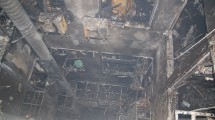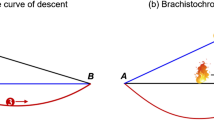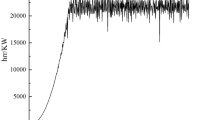Abstract
Here we see why humans unwittingly build fires that look the same: edifices of fuel, as tall as they are wide. The pile of fuel is permeable, air invades it by natural convection and drives the combustion. I show that the hottest pile of burning fuel occurs when the height of the pile is roughly the same as its base diameter. Future studies may address the shape effect of wind, material type and packing. Key is why humans of all eras have been relying on this design of fire “unwittingly”. The reason is that the heat flow from fire facilitates the movement and spreading of human mass on the globe.
Similar content being viewed by others
Introduction
Our bonfires are shaped as cones and pyramids, as tall as they are wide at the base. They look the same in all sizes, from the firewood in the chimney, to the tree logs and wooden benches in the center of the university campus after the big game. They look the same as the pile of charcoal we make to grill meat.
Why is this human preference for burning piles that look the same? Why do we build the same “edifice” of burning fuel every time? Why do we do it instinctively, without having to learn it in school or steal the idea from the neighbor?
Fire was good for movement (life) and because it was good it was adopted1,2,3,4,5,6,7. The adoption of fire in human civilization was a design change (a transition) of the same nature as the emergence of organs for vision in animal design, the emergence of turbulence in laminar flow, the emergence of terrestrial animal locomotion from swimming and the emergence of flying later on. This step occurred in an unmistakable direction, from no fire to fire, not the other way around. Why?
The answer is the same for all the transitions: to facilitate movement and mixing on earth. For us, fire means ultimately more movement for humanity on the landscape, in accord with the constructal law8,9. Fire accounts for many empowering features that enable the human mass to move more easily and for greater access. Controlled fire is a human contrivance for instant and portable shelter, which is good for the continuity of movement. With fire the early humans did not depend on caves for warmth, dryness and safety.
The shapes of piles of coal, stones, sand and other materials have attracted considerable attention in physics. The stability of piles of granular materials10 and the ‘fibrous’ distribution of forces through the material11 depends on pile shape. The wind and the packing density have a significant effect on the self-heating of coal piles12 and on erosion13. The shape and size of a pile of stones governs the total work spent on constructing the pile14. Although the fundamentals of fluid mechanics concerning flow through coarse deformable granular piles (e.g., fluidized beds) and permeable interfaces with ambient have received attention15,16,17, the effect of the shape of the burning pile on its temperature and heating performance was not questioned until now.
Results
Here is why our fires should be built to look the same. Consider the model of a burning pile of fuel as a volume V of height H, base dimension D and absolute temperature T. The volume is illustrated as a cone or pyramid in Fig. 1, but it can have any shape (such as a parallelepiped), provided that the height of the body is H and that the base area has a single length scale D (for example, round or square). The scale analysis reported below does not capture the effect of volume shape, cone versus pyramid, except for the aspect ratio of the volume profile, H/D.
The fire temperature (T) as a function of the shape of the profile of the pile of fuel.
The clashing asymptotes define this behavior and the method of intersecting the asymptotes18 pinpoints the architecture, the design. Photographs taken by Adrian Bejan.
The body of fuel is a porous medium through which fluid flows because of the buoyancy effect due to low density (hot) fluid inside the body and high density (cold) fluid outside the body. For a hot volume of height H, the pressure difference scale that drives fluid through the cone structure of temperature T is18

where ρ is the air density, averaged between the air outside and inside, β is the coefficient of volumetric thermal expansion, ΔT is the temperature difference T − T0, where T0 is the ambient temperature and g is the gravitational acceleration.
The flow of air and combustion gases through the body is modeled as Darcy flow through a saturated porous medium with known permeability K, which scales with the pore diameter squared18. The heat transfer from the surface of the body to the ambient is modeled as black body radiation. We consider this flow in the two extremes, a tall pile (H  D) and a shallow pile (H
D) and a shallow pile (H  D). The treatment is based on scale analysis, which means that we neglect dimensionless factors of order 1.
D). The treatment is based on scale analysis, which means that we neglect dimensionless factors of order 1.
Tall limit
The volume averaged velocity of the fluid that permeates through the body is oriented in the vertical direction,

where μ is the fluid viscosity, which is treated as constant. Combining Eqs. (1) and (2) we find that v ~ Kgβ ΔT/ν, where ν is μ/ρ. The scale of the mass flow rate through the tall porous body is

where D2 is the scale of the body cross sectional area. The heat generated by combustion inside the body is proportional to the flow rate of oxidant  therefore we represent it as
therefore we represent it as  where C accounts for the reaction of combustion and the heating value of the fuel19. The heat generation rate
where C accounts for the reaction of combustion and the heating value of the fuel19. The heat generation rate  is transferred to the ambient (T0) via radiation,
is transferred to the ambient (T0) via radiation,

with the observation that σ is the Stefan-Boltzmann constant and HD is the scale of the external surface of the tall body. Combining Eqs. (3) and (4) and noting that when T > T0 we can approximate ΔT ~ T and T4 –  ~ T4 and obtain the scale of the body temperature
~ T4 and obtain the scale of the body temperature

This result shows that the body temperature decreases as the body becomes taller. In practice, needed is a high temperature, therefore a shorter body is of interest. This is why we turn our attention to the opposite extreme:
Shallow limit
In a shallow porous body the volume averaged fluid velocity is oriented horizontally,

The mass flow rate is  where HD is the scale of the cross sectional area pierced by u. The radiation heat transfer rate is
where HD is the scale of the cross sectional area pierced by u. The radiation heat transfer rate is  where D2 is the scale of the external surface of the body. In place of Eq. (4) we write
where D2 is the scale of the external surface of the body. In place of Eq. (4) we write  and obtain the scale of the shallow body temperature,
and obtain the scale of the shallow body temperature,

This shows that the shallow design is also inferior, because the body becomes colder as it becomes more shallow.
Intersection of asymptotes
Together, the two extremes covered by the preceding analysis are represented by the two asymptotes sketched in Fig. 1. The actual curve that relates T to the aspect ratio H/D is a bell-shaped curve that fits under the intersection of the two asymptotes. Most useful is the design that offers the hottest fire. This design is easy to identify by finding the H/D location of the intersection of the two asymptotes, Eqs. (5) and (7) which is

The best edifice of fuel must be such that its height is comparable with its diameter at the base. This geometric conclusion is independent of the thermophysical properties that were necessary in constructing the model of the flow phenomenon (g, ρ, μ, ν, K, σ, C, β).
Alternatively, the analysis outlined between Eqs. (2)–(8), can be repeated while regarding the volume of fuel as fixed (V ~ D2H) and searching for the height H, or the base length D, for which T is at its peak. After the intersection of the tall and shallow asymptotes, the conclusion is that Hopt ~ V1/3, or Dopt ~ V1/3, is the same as in Eq. (8).
This conclusion does not change if we replace β with T–1, which is recommended by the ideal gas model for the fluid19. The scale of the peak temperature achieved when H ~ D is found from either Eq. (5) or Eq. (7), with β = T–1,

This confirms common knowledge: the fire is hotter when it “breathes” better, which happens when the permeability K increases.
Discussion
A fundamental result such as Eq. (9) also reveals aspects of behavior that are not accessible to the human senses. The temperature of the hottest fire increases in proportion with g1/4, therefore the same fire will be hotter in a higher-g environment, in a centrifuge rotating at high speed, or on a planet just like Earth but larger.
Important to keep in perspective is that the model described in the preceding analysis is perhaps the simplest imaginable. The model is an invitation to more focused studies aimed at additional effects that may affect the pile shape sensibly: the wind speed and direction, the type of fuel (coal, wood) and the packing (fine, coarse). For example, if the packing is coarse enough, the Darcy flow model will give way to more refined models20 that can be implemented numerically. If the wind is strong enough, the radiation heat transfer from the pile will be replaced by a conjugate radiation & convection heat transfer model.
Additional Information
How to cite this article: Bejan, A. Why humans build fires shaped the same way. Sci. Rep. 5, 11270; doi: 10.1038/srep11270 (2015).
References
Wrangham, R. Catching Fire: How Cooking Made Us Human, (Basic Books, New York, 2009).
Burton, F. Fire: The Spark That Ignited Human Evolution, (University of New Mexico Press, Albuquerque, 2011).
Richerson, P. & Boyd, R. Not by Genes Alone: How Culture Transformed Human Evolution, (University of Chicago Press, Chicago, 2008).
Bille, M. & Sorensen, T. An anthropology of luminosity: The agency of light. J Material Cult. 12, 263–284 (2007).
Wrangham, R. & Carmody, R. Human adaptation to the control of fire. Evol Anthropol. 19, 187–199 (2010).
Wiessner, P. Embers of society: Firelight talk among the Ju/′hoansi Bushmen, PNAS Early Edition; 2014; DOI:10.1073/PNAS.1404212111.
Chow, W. K. Building fire safety in the Far East. Archit Sci Rev. 48, 285–294 (2005).
Bejan, A. Maxwell’s demons everywhere: evolving design as the arrow of time. Nature Sci Rep. 4, 4017; doi:10.1038/srep04017 (2014).
Bejan, A. Why the bigger live longer and travel farther: animals, vehicles, rivers and the winds. Nature Sci Rep. 2, 594; doi:10.1038/srep00594 (2012).
Hartley, R. R. & Behringer, R. P. Logarithmic rate dependence of force networks in sheared granular materials. Nature. 421, 928–931 (2003).
Vanel, L., Howell, D., Clark, D., Behringer, R. P. & Clément, E. Memories in sand: Experimental tests of construction history on stress distribution under sandpiles. Phys Rev E. 60, R5040–R5043 (1999).
Moghtaderi, B., Dlugogorski, B. Z. & Kennedy, E. M. Effects of wind flow on self-heating characteristics of coal stockpiles. TransIChemE. 78 B, 445–453 (2000).
Toraño, A., Rodriguez, R., Diego, I., Rivas, J. M. & Pelegry, A. Influence of the pile shape on wind erosion CFD emission simulation. Appl Math Model. 31, 2487–2502 (2007).
Bejan, A. & Périn, S. Constructal theory of Egyptian Pyramids and flow fossils in general, section 13.6 in Bejan. A. Advanced Engineering Thermodynamics, 3rd ed. (Wiley, Hoboken, 2006).
Eames, I. & Duursma, G. Displacement of horizontal layers by bubbles injected into fluidized beds. Chem Eng Sci. 52, 2697–2705 (1997).
Eames, I. & Gilbertson, M. A. Mixing and drift in gas-fluidized beds. Powder Techn. 154, 185–193 (2005).
Eames, I. & Gilbertson, M. A. Aerated granular flow over a horizontal rigid surface. J Fluid Mech. 424, 169–195 (2000).
Bejan, A. Convection Heat Transfer, 4th ed., (Wiley, Hoboken, 2013).
Bejan, A. Advanced Engineering Thermodynamics, 3rd ed., (Wiley, Hoboken, 2006).
Nield, D. A. & Bejan, A. Convection in Porous Media, 4th ed., (Springer, New York, 2013).
Acknowledgements
Prof. Bejan’s research is supported by the US National Science Foundation on “Heat networks and energy & environment design”.
Author information
Authors and Affiliations
Ethics declarations
Competing interests
The author declares no competing financial interests.
Rights and permissions
This work is licensed under a Creative Commons Attribution 4.0 International License. The images or other third party material in this article are included in the article’s Creative Commons license, unless indicated otherwise in the credit line; if the material is not included under the Creative Commons license, users will need to obtain permission from the license holder to reproduce the material. To view a copy of this license, visit http://creativecommons.org/licenses/by/4.0/
About this article
Cite this article
Bejan, A. Why humans build fires shaped the same way. Sci Rep 5, 11270 (2015). https://doi.org/10.1038/srep11270
Received:
Accepted:
Published:
DOI: https://doi.org/10.1038/srep11270
This article is cited by
-
Convergent Evolution of Boats with Sails
Scientific Reports (2020)
-
Constructal approach to bio-engineering: the ocular anterior chamber temperature
Scientific Reports (2016)
-
Macroscopic irreversibility and microscopic paradox: A Constructal law analysis of atoms as open systems
Scientific Reports (2016)
Comments
By submitting a comment you agree to abide by our Terms and Community Guidelines. If you find something abusive or that does not comply with our terms or guidelines please flag it as inappropriate.




